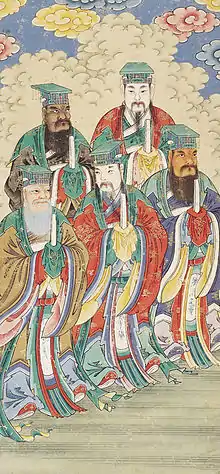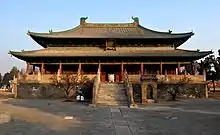Baidi (god)
Báidì (白帝 "White Emperor" or "White Deity") or Báishén (白神 "White God"), also known as the Xīdì (西帝 "West Deity") or Xīyuèdàdì (西岳大帝 "Great Deity of the Western Peak") is one of the five manifestations of the deity Shangdi. He is associated with metal, the west, and autumn.[1] As a human he was Shǎohào (少昊), and he is the manifestation of the supreme God associated with the essence of metal and autumn. His animal form is the White Dragon (白龙 Báilóng) and his stellar animal is the tiger. His astral body is Venus.[2]
| Baidi | |
|---|---|
 Diagram of the Wufang Shangdi | |
| Major cult centre | Mount Hua |
| Predecessor | Huangdi Wuxing cycle and political |
| Successor | Heidi (Wuxing cycle, also political with Zhuanxu) |
| Planet | Venus |
| Personal information | |
| Children | Taibai Jinxing Huayue Sanniang Huashan Sanlang |
Taibai Jinxing is his son.[3]
Uprising of the White Serpent
According to the legend of the "Uprising of the Slaying of the White Serpent" (Chinese: 斬白蛇起義), Liu's ascension to rulership was prophesied after becoming an outlaw. In the legend, a gigantic white serpent killed some of the outlaws with its poisonous breath; the serpent was killed by a drunk Liu during the night. The next morning, the outlaws encountered an old woman along the road; when asked why she was crying she mysteriously disappeared after replying: "My child, the White Emperor's son, has been slain by the son of the Red Emperor." Liu's reputation grew among his followers, who became convinced of his destiny.[4]
Xiyue Dadi

Xiyue Dadi (西岳大帝 "Great Deity of the Western Peak") is the god of Mount Hua and one of the Great Emperor of Five Mountains, identified with Baidi.[1] The belief of Emperor Xiyue originated from the worship of mountains and rivers in ancient China. Among the five great mountains, Mount Hua has long been respected for its proximity to Chang'an, the capital of Han and Tang Dynasties. Emperor Wudi built the first worship temple of him at foot of the Mount Hua, he named the temple Jilinggong Palace later changed to Xiyue Temple.[5] Xiyue Dadi is the father of Huayue Sanniang and Huashan Sanlang.
See also
References
- Sun, Xiaochun; Kistemaker, Jacob (1997). The Chinese Sky During the Han: Constellating Stars and Society. BRILL. ISBN 978-90-04-10737-3.
- Sun & Kistemaker (1997), p. 121.
- Walsh, Michael J. (25 March 2010). Sacred Economies: Buddhist Monasticism and Territoriality in Medieval China. Columbia University Press. ISBN 978-0-231-51993-9.
- (高祖被酒,夜径泽中,令一人行前。行前者还报曰:“前有大蛇当径,愿还。”高祖醉,曰:“壮士行,何畏!”乃前,拔剑击斩蛇。蛇遂分为两,径开。行数里,醉,因卧。后人来至蛇所,有一老妪夜哭。人问何哭,妪曰:“人杀吾子,故哭之。”人曰:“妪子何为见杀?”妪曰:“吾,白帝子也,化为蛇,当道,今为赤帝子斩之,故哭。”人乃以妪为不诚,欲告之,妪因忽不见。后人至,高祖觉。后人告高祖,高祖乃心独喜,自负。诸从者日益畏之。) Shiji, vol.08
- Palmer, David A.; Siegler, Elijah (2017-11-27). Dream Trippers: Global Daoism and the Predicament of Modern Spirituality. University of Chicago Press. ISBN 978-0-226-48484-6.
